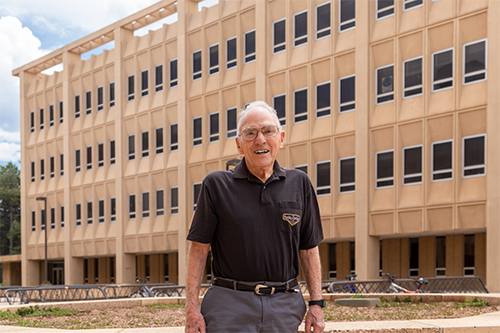A Look Back, A Look Forward
E.G. 'Gerry' Meyer

On the 58th anniversary of E. G. “Gerry” Meyer’s University of Wyoming hire date,
we had the privilege of sitting down with him to ask one single question, “How has
UW changed over the span of nearly six decades, and what, if anything, has stayed
the same?”
The question is not incidental. If given the opportunity to ask anyone in the history of the University of Wyoming what it has been like to witness the progression of UW, the former Arts and Sciences dean would be your best resource. Meyer, who is 101 years old, has not only seen and heard it all, he’s experienced it first-hand. At the heart of UW’s most remarkable transformations, you’ll find Meyer spearheading development and always advocating for the hardworking folks who make it happen.
To help answer the question, Meyer discloses a collection of compelling stories featuring individuals who laid the groundwork for the culture, infrastructure, and identity of the University of Wyoming. Each memory he shares illustrates the emergence of UW’s modern framework. Meyer’s oral history is invigorating in its sincerity. No detail is minimized for the sake of romanticizing the sacrifices made on behalf of the men and women who dedicated their lives to Wyoming’s university. Meyer may be the last living person to have been hired by legendary President George “Duke” Humphrey, whose legacy continues to impact every aspect of campus life still today. In 1963, the Duke summoned Meyer from New Mexico not only to become the new Arts and Sciences dean but also to address a serious dilemma—a dilemma that would be the catalyst for one of the University of Wyoming’s most remarkable transformations.
“What happened was, Humphrey had committed to the legislature and the citizens of Wyoming to build a new science center,” says Meyer. “He had already received $10 million from the State. He had planned to acquire the rest of the money from the private foundations of Ford and Rockefeller, but it turned out that these private foundations were not able to donate money for public university buildings. The Duke was stuck.”
Meyer was a pioneer, arriving at the University of Wyoming with the unique experience and perspective needed to take on the Duke’s vision. At the time, the Arts and Sciences college was Wyoming’s largest, taking on three new departments—Anthropology, Geography, and Psychology. Meyer administered 230 full-time faculty members in addition to raising money and overseeing the construction of the science center that included both the physical and biological science buildings, a science library, a computer center, and the Classroom Building.
“The board of trustees, bless them, had no concept of what was involved,” says Meyer. “And the idea was that we were going to just do more of what we were doing. My idea was to do more of something we were not doing.”
Meyer’s honesty about the university’s shortcomings in the 1960s is more inspiring than it is critical. His stories are of real people who were able to solve major problems with limited resources. This candid history offers something that is often glossed over—the fortitude of each individual who pushed for advancement during times of uncertainty, change, and progress. In every story Meyer shares, he draws attention to critical decisions made by a single person that impacted many. Some of these decisions and their weight were apparent at the time they were made; others revealed their significance later in history. What persists in every narrative is the pursuit of vision.
It’s easy to see why Meyer has been one of the university’s biggest supporters throughout his career and his retirement. Recently, he gifted his personal art collection to the University of Wyoming Art Museum. Meyer officially bequested his collection in 2012 in the form of a legacy gift; however, he and his family made the decision to relinquish the collection during Meyer’s lifetime. As a result, Meyer is witnessing the impact of his own legacy as it’s happening today.
One of Wyoming’s foremost art collectors, Meyer’s collection of paintings, sculptures, and drawings include original works by well-known artists such as Frederic Remington, Charles M. Russell, Joseph Sharp, William Gollings, Thomas Moran, John Clymer, and Edward Borein. The collection was started by his grandmother Anna Ilfeld, an early patron of the famed Taos artists of New Mexico. Over the years, he’s added to the collection.
“It all started with my grandmother—she was interested in art,” says Meyer. “She would go up and buy paintings from the Taos Society of Artists. She lived in a real nice house in Albuquerque and had these paintings. As I’m growing up, I’m looking at these paintings thinking, they’re really something. When my grandparents died, I inherited two or three of these paintings and set out to acquire more. I was hooked. I ended up getting them all. The collection just kept growing.”
Preserving histories large and small is something Meyer has carefully done throughout his lifetime. Creating history is something he continues to do. As the University of Wyoming evolves and we find ourselves in times of transformation, we look to Gerry Meyer for his guidance, his advice, and his moving stories.
